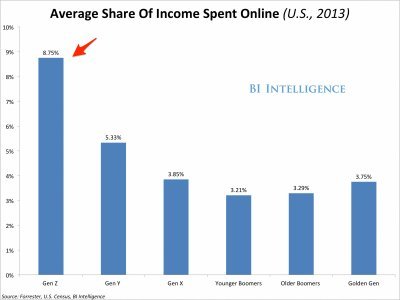Once upon a time in a far off digital land, there was a social media platform called Facebook that consumed much of Generation Y’s time in “liking” photos and posting comments. As generations grew and various interfaces emerged, Facebook seemed to remain popular with Gen X but would the younger Gen Z follow along with the Facebook trend?
Recent studies show that Millennials and Gen Z spend “a significant amount of their time online,” and a lot of that time has converted into spending actual dollars online. Gen Z spends almost twice as much money than Gen Y, thus making it important for marketers to follow along – what platforms are Gen Z finding ads from?

As a 25 year old female, a lot of the ads I wind up following come from Facebook. I don’t always click on Facebook ads (come on – I’m in digital advertising, I know better) but when I do, I typically end up spending money on a dress or a piece of jewelry I really don’t need. Plus, Facebook’s cleverly installed Custom Audience Pixels follow me from the Designer Handbag page on ThredUp to my Facebook news feed the second I log back in. With Millennials dominating Facebook, where is Gen Z hiding… and where are they spending their hard earned babysitting dollars online?
Kids are leaving Facebook. In fact, most aren’t even on Facebook – they begin their social media exploration at ages 10 or 11 through Instagram – posting poorly angled selfies and discolored photos of One Direction posters. With platforms like Instagram, Vine and Snapchat is it safe to say that Facebook is dead?
The latest Cassandra report found that “nearly half of young people] prefer that brands communicate with them on Facebook — over YouTube, Twitter, Instagram, Pinterest, and Tumblr. As they use Facebook more often than other platforms, it’s only fitting they want brands to reach them this way."
They also discovered that while each social medium has particular strengths and weaknesses for marketers, when asked, the young don’t just want to see content, but rather, according to Cassandra, brands "need to provide value, relevancy, and interactivity."
As for advertising, Facebook can help digital marketers customize specific “native” ad placements based on Facebook user data like age and gender, as well as advertisers’ customer data and Custom Audience Pixels.
So in the end, while it seems that kids aren’t quite on Facebook, they will be, and Facebook is already to welcome them to their privacy-intrusive digital marketing network with open arms.
What do you think? Should marketers continue to advertise for the big-spending youth on Facebook?
Adele Stewart is a Digital Media Strategist at Epic Web Studios, a web development & strategic planning firm in Erie, PA, and Public Relations blogger. If you have questions about running a successful digital advertising campaign, contact Epic Web’s Social Media team today!
LinkedIn: /AdeleMarieStew
No comments:
Post a Comment